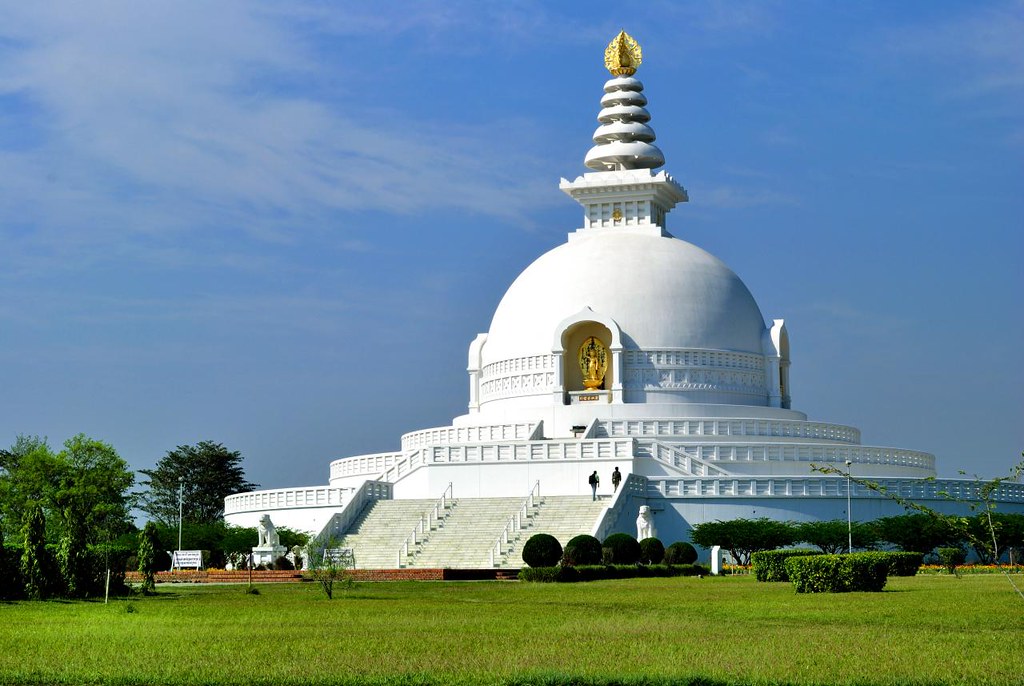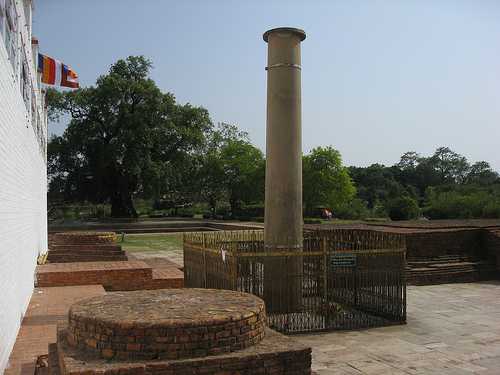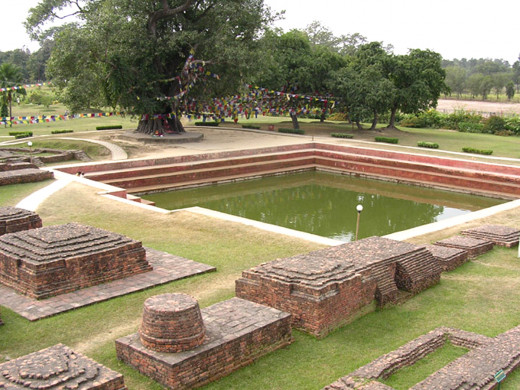Siddhartha Gautama, the Lord Buddha, was born in 623 B.C. in the famous garden of Lumbini, which soon became a place of pilgrimage. Among the pilgrims was the Indian Emperor Ashoka, who erected one of his commemorative pillars there. The site is now being developed as a Buddhist pilgrimage center where the archaeological remains with the birth of the Lord Buddha form a center feature.
Lumbini ( Sanskrit for "THE LOVELY") is a Buddhist Pilgrimage site located at the Nepalese town of Kapilvastu, district Rupandehi, near the Indian border. One of the world's most important spiritual sites is home to the historic birth place of the Buddha.
Lumbini is one of four Buddhist pilgrimage sites based on major events in the life of Gautama Buddha. Interestingly, all of the events occurred under trees.
The other three sites are in India:
1. Bodh Gaya (Enlightment).
2. Sarnath (First Discourse)
3. Kushinagar (Death)
Lumbini is a Buddhist pilgrimage site in the Repandehi district of Nepal. It is place where Queen Mayadevi gave birth to Sidhartha Gautam. Sidhartha Gautam lived roughly between 623 and 543 B.C. and he founded Buddhism as Gautam Buddha. Lumbini is one of four magnets for pilgrimage that sprang up in place pivotal to the life of the Buddha. It is one of the greatest pilgrimage sites for Buddhist. More than 400,000 Buddhist and non-Buddhist visit Lumbini every year. It is also UNESCO World Heritage Site (culture) and holds immense archaeological and religious importance. Mayavati Temple is one of the important sites in the Lumbini Garden. It is said that here the newly born prince took his first seven steps and gave a peace message to humanity. Lumbini is a small town in the Terai region is situated south of the foothills of the Churia Range. Terai is the granary of Nepal and also the home to Royal Chitwan Park. Lumbini is only a few kilometers across the Indian border in Nepal.
Lumbini is one of four Buddhist pilgrimage sites based on major events in the life of Gautama Buddha. Interestingly, all of the events occurred under trees.
The other three sites are in India:
1. Bodh Gaya (Enlightment).
2. Sarnath (First Discourse)
3. Kushinagar (Death)
Lumbini is a Buddhist pilgrimage site in the Repandehi district of Nepal. It is place where Queen Mayadevi gave birth to Sidhartha Gautam. Sidhartha Gautam lived roughly between 623 and 543 B.C. and he founded Buddhism as Gautam Buddha. Lumbini is one of four magnets for pilgrimage that sprang up in place pivotal to the life of the Buddha. It is one of the greatest pilgrimage sites for Buddhist. More than 400,000 Buddhist and non-Buddhist visit Lumbini every year. It is also UNESCO World Heritage Site (culture) and holds immense archaeological and religious importance. Mayavati Temple is one of the important sites in the Lumbini Garden. It is said that here the newly born prince took his first seven steps and gave a peace message to humanity. Lumbini is a small town in the Terai region is situated south of the foothills of the Churia Range. Terai is the granary of Nepal and also the home to Royal Chitwan Park. Lumbini is only a few kilometers across the Indian border in Nepal.
Lumbini is situated at the foothills of the Himalayas in modern Nepal. In the Buddha's time, Lumbini was a beautiful garden full of green and shady Sal Trees (shorea robusta) , The garden and its tranquil environs were owned by both the Shakyas and the clans. King Suddhodana, father of Gautama Buddha, was of the shakya dynasty and belonged to the kshatriya (warrior cast).
In 249 B/C., when the Indian emperor Ashoka visited Lumbini, it was
flourishing village. Ashoka constructed four stupas and a stone pillar
with a figure of a horse on top.
Major Attractions of Lumbini: The place itself is interesting as a whole, the landscape and the green forestry. However, Maya Devi Temple and the Stupas and the Pillar built by Ashoka are really worth a visit.. Recently, several beautiful shrines have been constructed by devotee from all over the world.
Buddhist Countries A visit to Lumbini, the birthplace of Buddha, is not only for spiritual enlightenment but also for solace and satisfaction that one gets in such calm and peaceful place. The major attractions of Lumbini are:-
World Peace Pagoda

World Peace Pagoda: Located outside the main compound, but easily accessible by bike., the impressive gleaming white World Peace Pagoda, one of the world's greatest stupas, was constructed by Japanese Buddhist at a cost of US $1 million. The shining golden statue depicts the Buddha in the posture he assumed when he was born. A walk around the stupa gives you panaromic view of Lumbini.
Things to Know:
Catogary- Historical, Heritage, Pilgrimage.
Language- Nepali, English.
Altitude- 100 M.
Best Time to Visit-April-May is the best time to visit Lumbini
The best season to visit Lumbini is from April-May when birth of Lord Buddha
is celeberated in a grand manner. During this period, Hindus gather here in
Maya Devi Temple, mother of Lord Buddha.
Nearby Airport
Bharatpur Airport- station code- BHR, distance-138.9KM
Simikot Airport- station code- IMK, distance-192.34KM
Pokhra Airport- station code- PKR, distance-197.89KM
The Bodhi Tree or Wisdom Tree

The Bod-hi Tree or Wisdom Tree: is a set of four distinct Buddhism Meditation. Each meditation is based on an insight that the historical Buddha was said to have experienced as he sat under the Bod-hi Tree more than twenty-four centuries ago. According to Buddhist tradition, the hours before the Buddha's enlightenment were divided into four watches or periods of the night. During each watch, the Buddha experienced a specific set of insights or revelations. During the last watch, as the morning star appeared on the horizon at dawn, then Buddha entered Nirvana. It
represents the place of the Buddha's enlightenment, and is therefore
sacred geographically. It is ancient. Thus it is sacred temporarily. It
represents growth towards liberation. Therefore, it is sacred
developmentally. In all these cases, the Buddha- Tree's symbolism gives
access to the Dharam Kaya, which is the most transcendent aspect of Buddhism.
The Bodhi-Tree is a symbolic representation of the individual's journey to infinity. As the seed which begins tiny and hard grows open and free, so should the mind and heart. The tree is rooted in the ground as the self is rooted in matter. But the seed grows beyond the ground, as it perceives its environment, cares about it, and ultimately leaves the limitations of the body and matter behind. The branches reach towards the heavens yet the vines of the banyan reach towards the earth. Such is the state of mankind- always being pulled in two directions. One direction is freedom, ultimate liberation, and the transcendence of boundaries. The other direction is severity, rootedness, comfort, and tradition-the self that will not turn away form the earth.
The Ashoka Pillar
The Bodhi-Tree is a symbolic representation of the individual's journey to infinity. As the seed which begins tiny and hard grows open and free, so should the mind and heart. The tree is rooted in the ground as the self is rooted in matter. But the seed grows beyond the ground, as it perceives its environment, cares about it, and ultimately leaves the limitations of the body and matter behind. The branches reach towards the heavens yet the vines of the banyan reach towards the earth. Such is the state of mankind- always being pulled in two directions. One direction is freedom, ultimate liberation, and the transcendence of boundaries. The other direction is severity, rootedness, comfort, and tradition-the self that will not turn away form the earth.
The Ashoka Pillar

The Ashoka Pillar: The Ashokan Pillar, essentially erected by Asoka (249 B.C.) visited Lumbiniand inscribed Asoka Pillar on the spot of Buddha's birth. The inscription of the pillar (the oldest in Nepal) declares the Asoka's granted Lumbini tax free status in honor of Buddha's birth. It is 6 m high and half of its beneath the ground. It is behind the Maya Devi Temple, to the west of the temple.The Ashoka Pillar is being made of pink sandstone. The pillar itself became lost over the centuries and only in 1895 was it rediscovered by a German archaeologist named Feuher besides some ruins which turned out to be the foundations under what is now known as the Mahadeva Temple that depicts the birthplace. In 1896 the pillar was moved by the governor of Palpa, Khadga Shumsher Rana back to its original place beside the temple. The Ashokan Pillar in Lumbini also takes the honor as being the oldest known inscription to be found in Nepal.
Maya Devi Temple

Maya Devi Temple:Lumbini remains neglected for centuries. In 1895, Feuhrer, a famous German archaeologist, discovered the great pillar, further exploration and excavation of the surrounding area revealed the existence of a brick temple and a sandstones sculpture within the temple itself which represents the scene of Buddha's birth. On the south of the Maya Devi Temple there is the famous sacred bathing pool known as Pushkarni. It is believed that Maya Devi took a bath in this pool before the deliver
Pushkarani Pond

Pushkarani Pond:The Pushkarani is the sacred pool where the Maya Devi, the Queen of Shakya King Suddhodhana of Kapilvastu the Lord Buddha's mother take a bath before giving birth to the Lord Buddha. It is also the Place where the Gautama was given his ritual purification.
Myanmar Golden Temple

The Myanmar Golden Temple is one of the oldest structures in the compound. There are three prayer halls- the most impressive is tapped by a Concob-shaped shikara (tower), styled after the temples of Bagan. Also within the temple grounds is the Lokamani Pula Pagoda, a huge gilded stupa in the southern Burmese style, inspired by the shwedagon paya in yongon.
Lumbini Museum

The museum displays artifacts from Mauryan and Kushana periods
The museum posses religious manuscripts, metal sculptures and stamps from all over the world depicting Lumbini. Lumbini International Research Institute ( LIRI ), located opposite the Lumbini museum, provides research facilities for the study of Buddhism and religion in general.
Excursion:
Kapilvastu: A holy destination related deeply with the life of a legend, Lord Buddha, eventually Kapilvastu is the place where Lord Buddha, had lived the childhood and the days of teenage, in complete luxury. The capital of king Shuddhodhan, Kapilvastu still carries with it the mystic charms. It houses many sculptures of Buddhism, which present a landscape before that visitors that makes them feel calm., content. Kapilvastu carries the visitors away to the ancient days when Buddha was a small child, a prince. The place is situated 27 km south of Lumbini.
Respect:
- Wear clothing that expresses respect for the sacred nature of the site.
- Circumnavigate the stupas and other sacred objects in a clock wise direction.
- Preserve the peace and tranquility.
- Do not climb onto stupas or other sacred objects.
Access and Accommodation:
Lumbini is a 10 hour drive from Kathmandu and a 45 minutes drive from Bhairahawa. The closest airport is Gautam Buddha Airport at Bhairahawa, with flights to and fro from Kathmandu.
Where to Stay: Some of the hotel in Bhairahwa are quite useful, but it is recommended to stay in the nearby Dae Sun Sukh Gu Sa monastery in the village.
